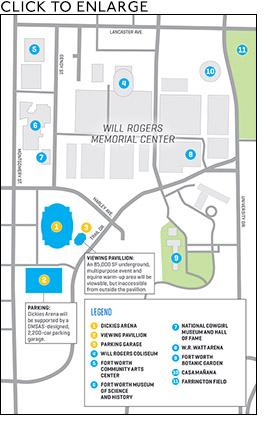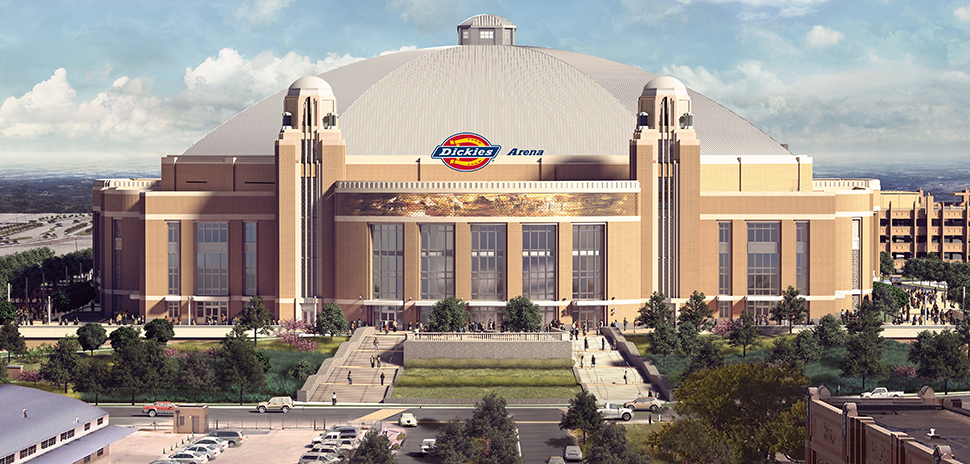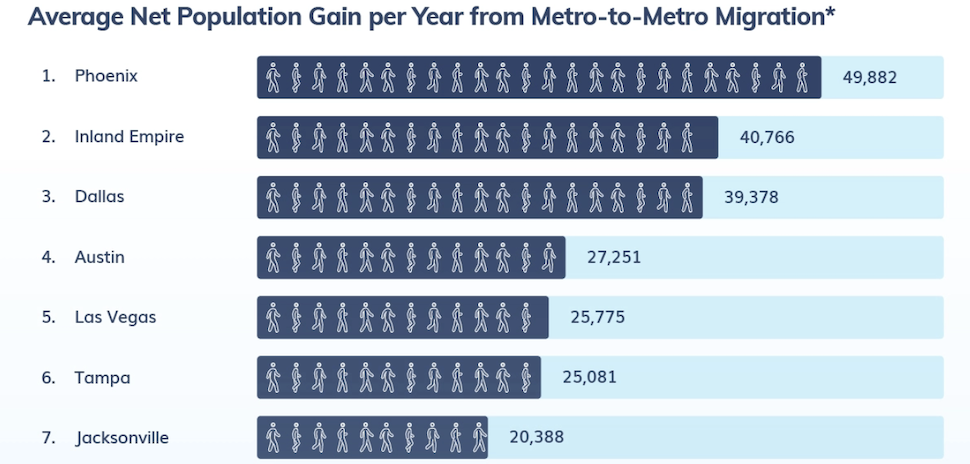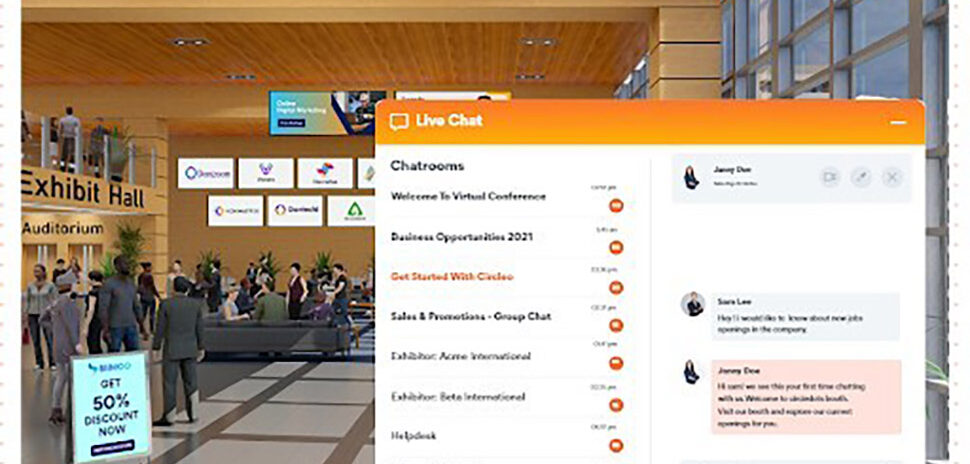Dickies Arena received its last ceremonial piece of steel this week. Carrying the signatures of more than 100 city leaders and representatives, the beam moved the massive multipurpose facility even closer to hosting big-name concerts, sporting events, rodeos, and family entertainment.
The 14,000-seat, $540 million venue is coming to life thanks to a unique blend of public and private money and the leadership from a member of one of the most prominent families in North Texas.
The arena will open in late 2019 at the southeast corner of Montgomery Street and Harley Avenue west of downtown, and the 2020 Fort Worth Stock Show & Rodeo will host its rodeo performances in the arena a few months later.
Other events already lined up include the 2020 through 2022 NCAA Women’s Gymnastics Championships and the American Athletic Conference men’s basketball championship from 2020 to 2022.
“The people of Fort Worth have really been underserved in the sport and entertainment side.”
Mike Homan
In 2022, the first and second rounds of the NCAA men’s basketball tournament will bring March Madness to Fort Worth.
And that’s just the beginning.
“The people of Fort Worth have really been underserved in the sport and entertainment side,” said Matt Homan, president and general manager of Trail Drive Management Corp. “We are booking concerts. We’re on the ground running.”
Other than the monthlong Fort Worth Stock Show & Rodeo, Dickies Arena will have advantages over other venues such as the American Airlines Center in Dallas and AT&T Stadium in Arlington, which must schedule around the Dallas Mavericks, Dallas Stars, and Dallas Cowboys.
“Our ability to schedule the new arena, at least in the foreseeable future, will be much more flexible,” said Mike Groomer, CEO and president of Event Facilities Fort Worth, a nonprofit organization started by chairman Ed Bass, who is leading the effort to privately fund more than half the cost of the facility by enlisting other wealthy individuals and foundations.
 “As the beautiful, impressive domed roof of Dickies Arena takes shape with new steel members added every day, I’m thrilled to think of what is to come under that roof,” Bass said. “I truly think whatever people expect, Dickies Arena and the events it hosts will be far more than they ever dreamed of.”
“As the beautiful, impressive domed roof of Dickies Arena takes shape with new steel members added every day, I’m thrilled to think of what is to come under that roof,” Bass said. “I truly think whatever people expect, Dickies Arena and the events it hosts will be far more than they ever dreamed of.”
THE PATH NOT TAKEN
Talk of a Fort Worth arena goes back about 25 years when North Texas put together a bid for the 2012 Summer Olympics. The building’s main focus, at the time, was to replace the aging Will Rogers Coliseum.
“But over time it was recognized that a new state-of-the-art arena could and should be truly multipurpose — bringing to Fort Worth and Tarrant County a whole new level of experience for not only rodeos, but also for concerts, sports, family shows, graduations, conventions, and community events,” Bass said.
“As the beautiful, impressive domed roof of Dickies Arena takes shape with new steel members added every day, I’m thrilled to think of what is to come under that roof.”
Ed Bass
The failure of the 2012 Olympic bid stung area leaders in the early 2000s, but sometimes it’s the road not taken that makes all the difference.
Talk picked back up again in 2008 but the recession hit, slowing momentum yet again.
“That vision for a new arena never went away,” Groomer said. “We just made strategic purchases, quietly buying land. We always had in mind that someday they would get an arena.”
Patience and persistence paid off, though, as Fort Worth was able to structure the deal its way, rather than rushing to meet an Olympic deadline.
Fort Worth established a public-private partnership deal where the public portion will be funded by those who use the facility and stay in the hotels around it.
“We didn’t want a property or sales tax increase and we couldn’t afford, nor did we want to have, a serious impact to our general fund,” Mayor Betsy Price said. “The plan, it’s even better now than it would have been then. The beauty of the arena, also, it’s going to belong to the city but it’s going to be privately managed. And, the upkeep of the arena comes out of profits generated so it’s not going on the books as a liability.”
PUBLIC-PRIVATE PARTNERSHIP LEADS TO DICKIES ARENA
Price explained how it came together, starting with the Texas Legislature in 2013.
Rep. Charlie Geren, R-Fort Worth, and Sen. Jane Nelson, R-Flower Mound, sponsored a bill that allows cities to allocate the state’s portion of the hotel taxes within a three-mile radius of a certain facility to pay off debt for capital improvements. Lawmakers approved Senate Bill 748, and it was signed by then-Gov. Rick Perry.
Now, hotel occupancy tax funds within a three-mile radius of the Fort Worth Convention Center and the Will Rogers Coliseum that would have gone to the state coffers are redirected to pay off the public portion of the debt for Dickies Arena. Hotel guests don’t notice any difference, the state’s portion is just reallocated.
Then, the city asked the voters to approve taxes that will be paid by users and those who visit the new arena. That includes a $5 parking tax, a $20 tax on livestock stalls and pens, and a 10 percent tax on tickets. All three propositions passed by 72 percent or more in November 2014.
“There are very few cities around that get a $550 million arena and the city’s paying less than half that.”
Mayor Betsy Price
Fort Worth has issued 25- and 30-year debt instruments to pay for the public share of the project, which is capped at $225 million.
“The public perception has been very, very good,” Price said. “It’s not a draw on city funds. Average Fort Worth citizens won’t be hit with it unless they’re using it. There are very few cities around that get a $550 million arena and the city’s paying less than half that.”
That’s where the private sector comes in.
Event Facilities Fort Worth, a nonprofit led by Bass, will pursue the private individuals and foundations to fund the remaining cost.
A separate entity called Trail Drive Management Corp. was created to manage the day-to-day operations of Dickies Arena. The 501(c)(3) has a 70-year lease on the building.
Dickies Arena will have a premium sound and lighting system for concerts and other events, as well as new restaurants, Price said.
Homan said they’ve even discussed having Mavericks or Stars preseason games at Dickies Arena, which would help the teams reach fans in the 817 area code and build excitement for the regular season.
In the future, the arena could attract a minor league team, Homan said.
Price said it’s not a priority right now, though.
“I think it’s possible, and we’ll look into it,” Price said. “Right now that arena’s going to get so booked, we may not have space for it.”
INSIDE THE CONSTRUCTION SITE
Four tower cranes loom over Dickies Arena as workers set up the trusses that will become the roof for the facility. Rising from the floor of the arena are two steel towers that will temporarily hold up the roof. Once the roof becomes self-supporting, the towers will be removed and the floor will be ready for the real action. It could have hardwood floors for basketball, a stage loaded with guitars, drums, and amps for a concert, layers of dirt for a rodeo, a ring for professional wrestling, or an ice skating rink for hockey games.
Making sure the arena reaches the finish line on time is Scot Bennett, regional director for The Beck Group.
Construction is more than one-third complete, and the scale of it even takes a veteran like Bennett aback.
“This is going to be one of the tallest arenas in the nation. It’s able to handle a lot of events that Fort Worth hasn’t been able to hold at this scale.”
Scot Bennett
“It’s really a fascinating picture, and it’s a fascinating construction process,” he said. “This is going to be one of the tallest arenas in the nation. It’s able to handle a lot of events that Fort Worth hasn’t been able to hold at this scale.”
There are premium rodeo boxes that will put people close to the action. There also are suites and loge boxes, which are mini suites that seat about five to six people. And there are the full-size suites.
The regular seating is specially designed for a more intimate feel so even people in the upper levels will feel part of the action. At each level, spectators will walk down to their seats rather than having to walk up.
DICKIES ARENA APPROACHES THE FINISH LINE
The Dickies Arena did displace some parking lots so the project also includes a new 2,200-spot parking garage specially designed for larger trucks that will be coming for rodeo-type events.
The peak of construction began in February, when an estimated 1,000 workers were working on the interior finish out of the 560,000-square-foot facility.
“We’ve been focused on trying to grow smaller, minority-based contractors and have become an incubator for smaller companies,” Bennett said. “We’re really creating a big impact with a job like this. We broke it down into smaller size pieces and held multiple outreach events and pair these smaller subs up with larger companies so they could play a role in the larger project.”
DICKIES ARENA BY THE NUMBERS
14,000
Seating capacity for concerts
13,300
Seating capacity for basketball games
12,200
Seating capacity for family shows and hockey games
9,300
Seating capacity for rodeo and equestrian shows
560,000
Square footage of the arena
150,000
Square footage of the support building
210,000
Square footage of the outdoor plaza
A version of this article appeared in the Dallas-Fort Worth Real Estate Review.
READ NEXT
Reinventing Ross Avenue: Retail, Restaurants, Residences Revitalizing Major Thoroughfare
![]()
Get on the list.
Dallas Innovates, every day.
Sign up to keep your eye on what’s new and next in Dallas-Fort Worth, every day.

































